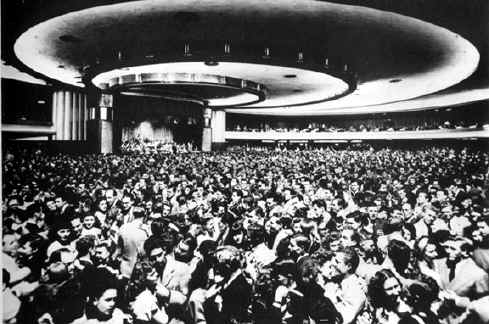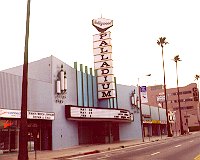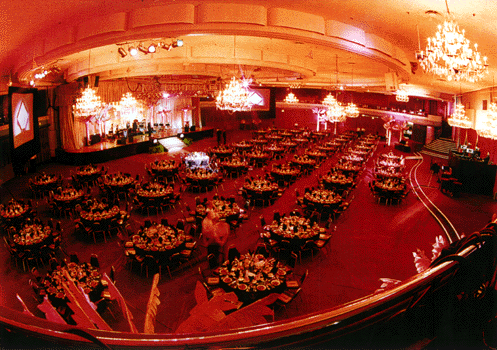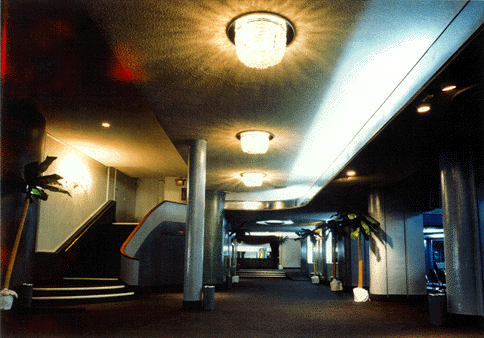 In
1940 The Tommy Dorsey Orchestra and its vocalist, the soon to become legendary
Frank Sinatra, opened the Hollywood Palladium to rave reviews. Over 6,500 people
attended each show during its peak, filling the dance floor, dining areas, and
mezzanine. Now the current owners are negotiating to sell this world famous
landmark for a residential and retail development that would cause its demolition.
In
1940 The Tommy Dorsey Orchestra and its vocalist, the soon to become legendary
Frank Sinatra, opened the Hollywood Palladium to rave reviews. Over 6,500 people
attended each show during its peak, filling the dance floor, dining areas, and
mezzanine. Now the current owners are negotiating to sell this world famous
landmark for a residential and retail development that would cause its demolition.

The usual question surfaces here again-where is our city’s political leadership
and why are we having to fight for a building that was supposed to have been
protected by the Hollywood Redevelopment Plan? This question will be foremost
when we look at the area’s two city council candidates, Eric Garcetti and
Michael Woo.The site can be developed around the Palladium.
The Palladium itself is a shamefully underutilized asset. Its large (12,000
sq. ft.) main room area and kitchen make it perfect for events and trade or
consumer shows (antiques, jewelry, collectables, etc.) that now take place at
other venues. The facility would then bring in a much-needed economic boost
for its owners and the Hollywood community, augmenting the concert and party
bookings.
 Every great
band played the Palladium from World War II into the 1960s (Phil Harris, Tex
Beneke, Glenn Miller, Stan Kenton, Harry James, Kay Kyser, Les Brown, Artie
Shaw, Gene Krupa, etc.). Then the Lawrence Welk show took over and broadcast
years of entertainment from there. Rock n’ Roll continued the music tradition;
The Kinks (singing their song about the Hollywood Walk of Fame, Celluloid
Heroes), Bob Dylan, The Police, James Brown, Rod Stewart, Led Zeppelin,
The Rolling Stones, The Sex Pistols, and just recently, Neil Young and Crazy
Horse with the Red Hot Chili Peppers, and Prince, to name but a few who graced
the Palladium stage.
Every great
band played the Palladium from World War II into the 1960s (Phil Harris, Tex
Beneke, Glenn Miller, Stan Kenton, Harry James, Kay Kyser, Les Brown, Artie
Shaw, Gene Krupa, etc.). Then the Lawrence Welk show took over and broadcast
years of entertainment from there. Rock n’ Roll continued the music tradition;
The Kinks (singing their song about the Hollywood Walk of Fame, Celluloid
Heroes), Bob Dylan, The Police, James Brown, Rod Stewart, Led Zeppelin,
The Rolling Stones, The Sex Pistols, and just recently, Neil Young and Crazy
Horse with the Red Hot Chili Peppers, and Prince, to name but a few who graced
the Palladium stage.
The Palladium was also a favorite of visiting dignitaries, hosting events for:
Robert F. Kennedy, Ronald Reagan, John F. Kennedy, Lyndon B. Johnson, Dwight
D. Eisenhower, Richard Nixon, Adlai Stevenson, and numerous awards shows including;
the Emmys, Grammys, NAACP Image Awards, and the Country Music Awards.
Recently, this landmark has been a victim of deferred maintenance and lackluster
bookings. The current owners, led by Steve Ullman of Grant Parking, are looking
to sell the Palladium and its surrounding property (parking lots for the most
part) for a residential / retail development. They are showing no interest in
preserving the Palladium. It should be remembered that the same Mr. Ullman showed
the same lack of interest in preserving Hollywood’s history when he demolished
the Brown Derby Restaurant, and also proposed to build a modern glass box building
next to Grauman’s Chinese Theater (a project defeated by Hollywood Heritage).
Remember this the next time you choose Grant Parking.
Part of a group of Streamline Moderne architectural wonders created for the
entertainment industry–CBS (1938), NBC (1938 –demolished), and the
Earl Carroll Theater (1938, now the Aquarius / Nickelodeon)–the Palladium
played a major role in creating the importance of classic radio (since WWII)
and television (since KNXT-TV started landmark broadcasts there in the early
1950s) in Hollywood, as well as being used as a movie location for; The Bodyguard,
Steven Speilberg’s 1941,What’s Love Got to Do With It, The
Blues Brothers, The Sinatra Story (mini-series), etc. and most recently,
Almost Famous.
 With
the current attack on the Hollywood Bowl, this attempt to demolish the Hollywood
Palladium would eliminate the two principle performance venues for live music
and special events in Hollywood. In a historic sense, there would be no history
left in Hollywood for one of our main contributions, the live music industry
(these two venues have been the home to over 90% of Hollywood’s significant
music performances and events).
With
the current attack on the Hollywood Bowl, this attempt to demolish the Hollywood
Palladium would eliminate the two principle performance venues for live music
and special events in Hollywood. In a historic sense, there would be no history
left in Hollywood for one of our main contributions, the live music industry
(these two venues have been the home to over 90% of Hollywood’s significant
music performances and events).
It is time for Mr. Ullman and his partners to either effectively run the Palladium
or find someone else who will–demolition is not an option. The Palladium
can, and should, be profitable, a resource for the community. The city needs
to enforce its laws and legally protect Hollywood’s history. Otherwise,
it’s back to the courts.
 In
1940 The Tommy Dorsey Orchestra and its vocalist, the soon to become legendary
Frank Sinatra, opened the Hollywood Palladium to rave reviews. Over 6,500 people
attended each show during its peak, filling the dance floor, dining areas, and
mezzanine. Now the current owners are negotiating to sell this world famous
landmark for a residential and retail development that would cause its demolition.
In
1940 The Tommy Dorsey Orchestra and its vocalist, the soon to become legendary
Frank Sinatra, opened the Hollywood Palladium to rave reviews. Over 6,500 people
attended each show during its peak, filling the dance floor, dining areas, and
mezzanine. Now the current owners are negotiating to sell this world famous
landmark for a residential and retail development that would cause its demolition.
 Every great
band played the Palladium from World War II into the 1960s (Phil Harris, Tex
Beneke, Glenn Miller, Stan Kenton, Harry James, Kay Kyser, Les Brown, Artie
Shaw, Gene Krupa, etc.). Then the Lawrence Welk show took over and broadcast
years of entertainment from there. Rock n’ Roll continued the music tradition;
The Kinks (singing their song about the Hollywood Walk of Fame, Celluloid
Heroes), Bob Dylan, The Police, James Brown, Rod Stewart, Led Zeppelin,
The Rolling Stones, The Sex Pistols, and just recently, Neil Young and Crazy
Horse with the Red Hot Chili Peppers, and Prince, to name but a few who graced
the Palladium stage.
Every great
band played the Palladium from World War II into the 1960s (Phil Harris, Tex
Beneke, Glenn Miller, Stan Kenton, Harry James, Kay Kyser, Les Brown, Artie
Shaw, Gene Krupa, etc.). Then the Lawrence Welk show took over and broadcast
years of entertainment from there. Rock n’ Roll continued the music tradition;
The Kinks (singing their song about the Hollywood Walk of Fame, Celluloid
Heroes), Bob Dylan, The Police, James Brown, Rod Stewart, Led Zeppelin,
The Rolling Stones, The Sex Pistols, and just recently, Neil Young and Crazy
Horse with the Red Hot Chili Peppers, and Prince, to name but a few who graced
the Palladium stage. With
the current attack on the Hollywood Bowl, this attempt to demolish the Hollywood
Palladium would eliminate the two principle performance venues for live music
and special events in Hollywood. In a historic sense, there would be no history
left in Hollywood for one of our main contributions, the live music industry
(these two venues have been the home to over 90% of Hollywood’s significant
music performances and events).
With
the current attack on the Hollywood Bowl, this attempt to demolish the Hollywood
Palladium would eliminate the two principle performance venues for live music
and special events in Hollywood. In a historic sense, there would be no history
left in Hollywood for one of our main contributions, the live music industry
(these two venues have been the home to over 90% of Hollywood’s significant
music performances and events).